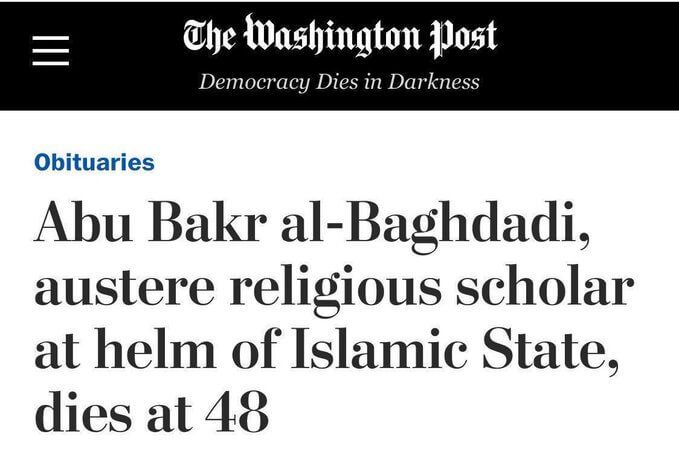There are numerous expressions of media bias. From lack of balance in column inches and unequal airtime in panel conversations to usage of misleading or photoshopped images, there are many different ways in which reporting can fail to accurately reflect reality. Many are often pointed out swiftly on these pages.
But what to do when an obituary distorts reality?
Join the fight for Israel’s fair coverage in the news
A well-written obituary seeks to provide readers with fascinating anecdotes, insights, and a textured documentation of the life and times of an individual in the public eye.
As with any article, obituaries should be balanced, and depict both the good and the bad aspects of a person’s character and deeds. Their writers should strive for balance, aiming for an evenhanded piece that is neither a tribute nor a character assassination.
Headlines need to get the big picture right
Unfortunately, all-too-often, obituaries fall into the trap of describing the subject through a particular lens, or of downplaying certain aspects of an individual’s life while exaggerating others.
As with all journalism, obituaries should aim to be hard-hitting and pull no punches. If someone is a murderer, a terrorist, or committed any kind of wrongdoing during their lives, especially when on a grand scale or involving extreme violence, this cannot be overlooked. Purging these details is a gross failure of reporting and misleads readers.
For example, the Washington Post faced severe criticism in late 2019 when it described Abu Bakr-al-Baghdadi, leader of the murderous Islamic State, as an “austere religious scholar” the day after his death.

The Washington Post later changed the headline to the far more fitting “Abu Bakr al-Baghdadi, extremist leader of Islamic State, dies at 48.”
In a further twist, the first version of the Washington Post’s headline had called Baghdadi “terrorist-in-chief.” It seems that a deliberate decision was made to avoid the term “terrorist”, with news media having moved away from the word over the last two decades in favor of terms such as “militant” and “fundamentalist”. But in so doing, the headline totally erased al-Baghdadi’s primary identity as an extremist behind one of the world’s most feared and dangerous terrorist militias.
The appalling headline sparked a wave of criticism on Twitter, with users using the hashtag #WaPoDeathNotices to tweet mock obituary headlines for infamous historical figures.
“Adolf Hitler, dedicated art enthusiast, animal rights activist, and talented orator, dies at 56,” one ironic tweet read.
Beyond headlines subheadline 2
As Nick Serpell of the BBC writes, “an obituary is a broad-brush look at someone’s whole life, so avoid the temptation to give undue weight to events later in life purely because they are more recent.”
For example, while Palestinian leader Yassir Arafat was generally known to Western audiences as a statesman and for his role in peace negotiations with Israel in his latter years, he had an extensive histories of incitement, fomenting unrest and rewarding terrorism. Nevertheless, many of the obituaries written about him excised the extent and duration of his involvement in terrorism, instead depicting him as a militant-turned-realist who had eschewed terrorism in favor of peacemaking.
And in 2004, after Hamas leader Sheik Abdel Aziz Rantissi was killed in an Israeli targeted assassination, the Observer’s obituary urged readers to remember the Hamas leader’s softer side. A man who had declared, “Bush is the enemy of God, the enemy of Islam and Muslims,” and that “God declared war against America, Bush and Sharon,” was instead portrayed as a reasonable, child-loving subtle man who had opted to turn extreme for the noble cause of ‘saving Palestine’.
As with other forms of journalism, writers should also be careful not to throw in unsubstantiated claims. For example, in an otherwise fine 2016 New York Times obituary of former Israeli president Shimon Peres, a passage referred to the outbreak of the Palestinian Second Intifada as in response to a visit to the Temple Mount by then-Israeli opposition leader Ariel Sharon, despite an abundance of evidence from Palestinian and American sources declaring that the Intifada was planned well in advance.
This was not the only flawed obituary for Peres. One of the major challenges confronting obituary writers is the need to skip over fine details. One sentence in The Times of London’s obituary described hostages held by terrorists in a 1976 airplane hijacking “Israeli passengers,” whereas many of those held were not Israelis, but Jewish citizens of other countries. In blurring the lines, the Times obscured the hijackers’ antisemitic motives. In seeking to abbreviate a complex episode into a single paragraph, a critical element was omitted, leaving readers misinformed.
More recently, when long-time Palestinian politician and diplomat Saeb Erekat died, he was commemorated in much of the Western media as a “moderate” and a “peace negotiator”. Very few news outlets mentioned Erekat’s long history of poisoning the conversation with misleading statements and even outrageous lies about Israel, bringing both sides farther from reconciliation. Media reports and about his death routinely skipped over these inconvenient details, instead portraying him as a loyal and respected negotiator for peace. In so doing, numerous journalists were guilty of depicting Erekat as they perceived him; not as he really was.
A similar phenomenon was at play in many of the obituaries of veteran Middle East correspondent Robert Fisk. Here was a man who repeatedly invented quotes from imaginary interviewees, distorted the truth, and fabricated events and ‘facts,’ and was nevertheless widely lauded as an icon of journalism. Instead of grasping the opportunity to highlight his strengths and weaknesses, obituaries almost uniformly failed to mention Fisk’s ethical failings. As before, Fisk was depicted not as he really was, but as his erstwhile colleagues viewed him. Perhaps an additional factor involved here is the unwillingness of journalists to publicly criticize other reporters, especially post-mortem.
Image choices frame news consumers’ perceptions
Images, too, are of critical importance in obituaries. Take a look at the pair of images below.
In 2014, the shooting of Michael Brown ignited waves of unrest and protest in Ferguson, Missouri. Some claimed that Brown was an innocent victim of police violence, while others saw white police officer Darren Wilson as the victim of an anti-police narrative.

On the left is the image of shooting of Brown used by many media outlets in the aftermath of the killing. On the right is another image that surfaced on social media. The two images convey very different meanings, with one showing a smiling student, the very picture of success, and the other featuring a bare, tattooed arm, a back-to-front baseball hat, and a brooding, possibly cocky, look which suggests that the subject of the photograph may not be all-too-friendly.
Whatever your position on this particular issue, all sides agree that a media outlet’s choice of image subconsciously informs readers opinions.
Whither the truth?
Ask any journalist, and he or she will tell you that the truth is the single most important element in their line of work. Indeed, ask most humans, and they will say that the truth is perhaps the most important thing in all situations. In reality, that’s not entirely true. Whereas humans do indeed generally value truth, there are times when departures from the absolute truth are accepted in the name of other values, such as co-operation and to avoid upsetting others.
It’s clear that, in life, people strike a balance between sticking rigidly to the truth and abiding by social norms.
It’s important to remember that newspapers are written by humans. Not every instance of media bias is evidence of intolerance or hatred. The reality is that humans are flawed, and sometimes those flaws affect our work. And so, when writing an obituary, there is a natural temptation in some cases to avoid telling the full truth about the deceased. After all, the dead cannot defend themselves, and so some writers may be disinclined to recall the more controversial or brutal aspects of a person’s personality or deeds.
News agencies with the resources to do so write obituaries for especially prominent individuals in advance of their death. Doing so helps the writer not only publish relevant content fast, but also enables such pieces to be properly researched and thereby present a more accurate, richer, multi-faceted picture to readers.
Just as with any other piece of writing, obituaries should be balanced, honest, and tell the full story.


